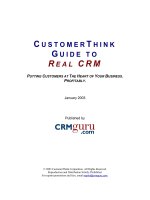Social Media Engagement: Guide To Real Time Publishing And Online Conversations
Bạn đang xem bản rút gọn của tài liệu. Xem và tải ngay bản đầy đủ của tài liệu tại đây (4.48 MB, 59 trang )
SOCIAL MEDIA
ENGAGEMENT:
The Pragmatic “How To” Guide to
Real-Time Publishing and Online
Conversations for Big Marketers
Word on the web: social media is simple. But for
large marketers — especially with multiple regions,
audiences and brands — social media engagement is
complicated stuff. This ebook cracks the complexities
and maps a path to actually engage in real-time
publishing and active responding. The prize at the
end of this e-rainbow is big: the ability to spread
your story and nudge people down the sales funnel at
zero incremental cost.
WHY IS THIS IMPORTANT?
BECAUSE SO-CALLED “SOCIAL MEDIA” SOON WILL BE
CALLED JUST PLAIN “MEDIA.”
This ebook is a graphic white paper; short on words, long on illustration and easy (we hope) to
digest. But some information requires a few hundred words to convey properly and so we open
with some text to create context. You can happily skip this intro if you are not a fan of words.
But we believe you’ll be rewarded if you take a few minutes to read the following paragraphs
before launching into the nitty-gritty of our book.
This ebook is based on our conviction that “social media” soon will be called just plain “media,”
and the world will accept that the power to publish or broadcast to large audiences has passed
irrevocably from a select few to virtually everyone. It is common wisdom these days that
marketers no longer own their brands—the audience does. Understanding this truth is critical,
because marketers are no longer the masters of communicating about their brands—social
networks have given that power to everyone. This profoundly game-changing democratization of
mass communications is only going to accelerate. On many occasions, social media has already
trumped the power of traditional media, garnering bigger audiences than TV and forcing the
mainstream media to follow what’s happening on Twitter or Facebook. As this phenomenon grows,
national newspapers, network TV and brand advertisers are becoming, in effect, just another
voice in the crowd. This rapid change in the power relationships among marketers, traditional
media companies and audiences is what’s tearing the mainstream media apart these days.
When the transformation is complete, brands without a credible presence on social networks
will cease to be competitive.
ON THE RIGHT DAY, WITH THE RIGHT STORY,
ANYONE CAN COMMAND A BIGGER, MORE ATTENTIVE
AUDIENCE THAN ANY TV NETWORK.
A single blogger can force the mainstream media to cover a story they would otherwise have
ignored. On the other hand, a brand marketer who has cultivated credibility with the brand’s
audiences can respond instantly and turn a terrible story into a positive one for a brand. Just as
important, while
The New York Times
may give a brand’s products a bad review, the brand itself
now can command a bigger, more important (in terms of influence, relevance and sheer size)
audience than
The Times
can, with greater credibility—so long as the brand shares the right
content and manages its social media interactions wisely.
These are just a few examples of the ways in which traditional power relationships in media have
been disrupted permanently. While there is a potential downside to being just another voice in
the crowd, there’s an upside as well: In a world where anyone can captivate a global audience
virtually for free, a brand marketer can, too. On the right day, with the right preparation and the
right story, a brand can enjoy a more powerful voice than any media organization on earth.
This total turnaround in the power structure of media will be devastating for brands that don’t
embrace the opportunity to publish on social networks.
THE UPSIDE IS INFINITE.
For brands that do it right, there is a lot of great news in social media: The power of a good brand
story will be multiplied many times over by the voices of the brand’s fans and advocates; the cost of
media will plummet for most brands because distribution costs on social media are close to zero; the
ability to understand consumers’ desires and needs will skyrocket because brands that listen can
literally read people’s thoughts on these new channels; brands can respond instantly to consumer
concerns and complaints, preserving relationships instead of losing a customer; and brands can grow
much closer to their only source of success — the customer. All this has enormous potential to create
huge efficiencies, lower marketing and research costs, improve products and services, increase speed
to market and, ultimately, make more money.
What’s required to avoid oblivion and reap this bonanza is the commitment and ability to create and
share credible, valuable content that tells the brand story in engaging, compelling and endlessly
various ways — stories that add value to people’s lives with information and entertainment. This
means that brand organizations are going to have to summon the courage to reshape internal
organizations, re-allocate resources, realize openness and re-align agency rosters to enable real-time
publishing through social networks.
That’s our social media vision in a nutshell. The rest of this ebook is about answering the complex
questions that must be faced to re-configure your marketing organization to reap the rewards of these
new platforms.
THIS INTRODUCTION WAS ADAPTED FROM A POST WE
DID FOR OUR BLOG, WWW.POSTADVERTISING.COM
TO READ THE WHOLE POST, CLICK HERE:
/>media-overpowers-NBC-A-vision.aspx
we point out in an earlier
eBook*, there’s a conversation
going on about your brand,
whether you like it or not.
Time to engage.
But how?
AS
*WE LAID OUT A COMPLETE THEORY OF SOCIAL MEDIA,
ADAPTABLE TO ANY COMPANY, IN OUR PREVIOUS
EBOOK. YOU CAN DOWNLOAD IT RIGHT HERE:
/>How do I get started? • What does a social media strategy look like? • What do I
say? • How do I staff it? • What’s the range of skills I need? • Do I want a blog or a
forum? Or neither? Or both? • What software works best? • How do I set KPIs? •
What listening tool is best? • What will it cost? • How do I decide what to respond
to? • How can I be sure what to ignore? • How do I keep up with the FTC’s ever-
changing regulations? • How do I respond in real time when it takes me 12 days to
get stuff through legal? • Do I need an agency? • What does my lead social media
agency do? • What do my other agencies do? • What do I handle internally? • Can
I measure the ROI? • What if there’s a backlash? • What if I create more problems
than I cure? • Do I allow public comments on my sites? • How do I do that? • What
if someone posts something completely outrageous? • Do I need to use video? • Do
I have to write everything myself, because I do NOT have time and I can’t write. •
How do I handle blogger outreach? • How do I budget for social media? • Can I
outsource social media or do I have to do it all myself? • How can I schedule social
media programs? • How do I get started? • What does a social media strategy look
like? • What do I say? • How do I staff it? • What’s the range of skills I need? • Do I
want a blog or a forum? Or neither? Or both? • What software works best? • How
do I set KPIs? • What listening tool is best? • What will it cost? • How do I decide
what to respond to? • How can I be sure what to ignore? • How do I keep up with
the FTC’s ever-changing regulations? • How do I respond in real time when it takes
me 12 days to get stuff through legal? • Do I need an agency? • What does my lead
YOU PROBABLY HAVE
SPECIFIC QUESTIONS.
THIS eBOOK WILL HELP YOU
FIND SPECIFIC ANSWERS.
of CMOs
like this.
100%
THIS IS ALL VERY
IMPORTANT BECAUSE
THE PRIZE IN THIS
CRACKER JACK BOX
IS THE ABILITY TO
DISTRIBUTE BRAND
MESSAGES AT
VIRTUALLY NO COST
BEYOND CREATIVE
COSTS, WHICH IS THE
WAY OF THE FUTURE.
Social media promises to defy the old adage: “You can’t have fast, good and cheap.”
Now you can have all three—relatively speaking—and that’s why
EVERYONE IS DOING IT. For better and for worse.
But relatively few people UNDERSTAND HOW TO DO IT.
FOR THE FIRST TIME IN HISTORY,
YOU CAN AFFECT BRAND
PERCEPTION instantly AND
efficiently.
is NOT a risk-free strategy.
DOING NOTHING
UP UNTIL A YEAR AGO, saying “no” to social media was a safe course of
action for anyone who wanted to stay employed in marketing. But 2009 was the
year when just saying “no” became a risky proposition. The deep recession
(forcing everybody to do more marketing with less money), combined with
increasing resistance to traditional advertising and the rapid upswing in online
social interactions, all made social messaging a necessary choice.
You cannot HOLD THE MORAL HIGH GROUND if everyone knows that you never fire.
CORPORATE SILENCE tells the web
community YOU DON’T CARE…or you
have SOMETHING TO HIDE.
GETTING STARTED SHOULD BE easy
BECAUSE THE REIGNING THEORY IS THAT
SOCIAL MEDIA ENGAGEMENT IS EASY!
(AT LEAST IN THEORY.)
THIS QUOTE FROM SOCIALMEDIATODAY.COM
IS TYPICAL:
“Social media isn’t complicated. When you
boil it down it’s about listening to your
customers, being helpful by offering your
knowledge and giving them interesting content
to share and thereby advocate for you.”
BUT THAT’S JUST THEORY.
IN THEORY, TRAVEL TO MARS IS easy:
Just get in a rocket and go!
BUT IN PRACTICE,
IT REQUIRES ROCKET SCIENCE.
In practice, doing social media right is complex.
Astonishingly complex.
Multi-agency teams must listen, think and publish in real time, prioritizing dozens or
hundreds of conversations on behalf of big, multi-brand marketers across the globe.
To pull it off, you must embrace that complexity.
We have some experience actually doing all this and we’d like to share some of
what we’ve learned.
ENGAGEMENT IS NOT ABOUT DUELING
WITH CRITICS. IT’S ACTUALLY ABOUT:
Diving into your brand’s conversation.
Enthusiastically. There is the potential to do great good and to avert great evil.
Publishing in real time.
Publishing content people will welcome and comments they’ll respect.
And doing it NOW.
Revealing that there are humans in your organization.
Corporations are easy to hate, particularly online.
People are easier to like (and to forgive).
Connecting with the people telling your story.
So that you can start telling your story, too.
“To thine own
self be true,
And it must follow,
as the night the day,
Thou canst not then
be false to any man.”
—Polonius, in Hamlet
BEFORE DOING ANYTHING,
MAKE SURE YOU KNOW
YOUR BRAND AND YOUR
BRAND’S STORY.
WHAT IS THE BRAND
ALL ABOUT? WHAT IS
THE CORE BRAND
NARRATIVE?
WHO ARE YOUR AUDIENCES—
INTERNAL AND EXTERNAL?
WHAT ARE THEIR MEDIA
HABITS? PASSIONS? PAINS?
EXPECTATIONS?
WHAT’S YOUR
COMPETITION DOING?
WHAT CAN YOU OFFER THAT
YOUR CUSTOMER CAN’T GET
ELSEWHERE?
BRAND
AUDIENCE
CATEGORY
EVERY BRAND HAS THREE ESSENTIAL PILLARS, and you need to know
everything possible about your brand’s pillars or you will not succeed in social
media (or any other media, for that matter). This means, at a minimum, knowing
how your brand thinks, behaves and tells its core story; how your various
constituencies encounter and relate to the brand; and where the brand sits
in its competitive landscape.
IF A BRAND IS GOING TO TELL ITS STORY,
IT MUST BE SOLID ABOUT WHO IT IS.
o, once you know who you are,
how do you succeed?
How do you participate in your
brand conversation in a way
that’s purposeful,
impactful…and welcome?
What are people saying about you?
How powerful are they?
When they speak, do others
“pass it on”?
Are their issues real or perceptual? How should you address them?
What do they love about you?
What do they hate?
LISTENING TO SOCIAL MEDIA IS ONE
ESSENTIAL WAY TO BEGIN LEARNING MORE
ABOUT YOUR BRAND AND HOW IT’S SEEN.
*
*We’ll talk about who listens and what tools they should use a bit later.
IT DOESN’T NEED TO BE 1,000 PAGES
of agency boilerplate. But it absolutely,
positively must contain details of your:
• Social media strategy
• Timeline
• List of pre-launch to-do’s
• Social media listening set-up
• Analysis of initial listening
• Engagement plan
• Engagement start-up
NEXT, YOU NEED A STRATEGIC PLAN
Photo by Sean Stayte. Used with permission.
IT MUST POWERFULLY ENABLE YOU
TO TELL THE STORIES YOU NEED TO TELL
TO ENGAGE THE PEOPLE
YOU NEED TO REACH.
What do you want to accomplish?
Have clear, measurable goals that ladder to a business goal. “Building buzz”
is not a clear goal. “Drive influencer interest in website” is.
Whom do you want to talk to?
Make sure your target audience actually engages in social media in ways that can be
helpful to your brand. Then segment the messaging by audience members’ positions in
the purchase funnel (awareness, consideration, shopping, etc.) so you can nudge them
toward purchase and loyalty.
Which social media platforms, software, etc., should you use?
Depending on goals and audience, do you want to build a foundation on a Wordpress
blog or a Jive SBS forum? To listen with Buzzmetrics or Trucast? These are just two of
the dozen or so critical decisions that will shape your brand’s future on the social web.
How will you measure success?
Set the metrics and KPIs that will be used to determine the success
or failure of your social media efforts. Be sure to tie them to
business goals. “Twitter followers” is a very useful metric, especially
if you make money on each Twitter follower your brand attracts.
Some key questions for your
STRATEGIC PLAN
1
ST
THING TO KNOW ABOUT YOUR AUDIENCES IS
how and how much THEY ENGAGE IN SOCIAL MEDIA.
are the few and powerful who actually create content
and publish it in social media.
CREATORS
CRITICS
COLLECTORS
JOINERS
SPECTATORS
Forrester Research in 2006 invented “social technographics,” which splits all humanity into six groups
according to the activities they participate in at least monthly on social media. Here are the definitions of
those six categories in the social media participation pyramid. The group not pictured in the pyramid is the
Inactives—those who do not participate. But they are a rapidly shrinking category.
rate and review products/services, comment on blogs,
participate in forums, edit wikis.
use RSS to “collect” content, vote up content on sites
like Digg, tag photos and web pages.
maintain profiles on and visit social sites.
just watch—reading blogs, looking at videos, paying
attention to social sites.
BY Q2 2009, 82% OF WEB USERS WERE
ACTIVE IN SOCIAL MEDIA
Not surprisingly, Forrester finds
that people who create content
are now the minority at the top of
the social media pyramid. But by
2009, nearly everyone online
was at least a spectator to the
social media show, underlining
the explosion in social media
participation over three short
years. Each brand’s approach
to its audiences in social media
will be determined by how the
audience members index in
each category of social techno-
graphics. As participation grows,
however, more and more people
will move up the pyramid. Brand
strategies will become more
uniformly dependent on the use
of social media, at which point
social media will become a
critical part of virtually every
brands’ media mix.
2
ND
STEP WITH AUDIENCES: SEGMENT
MESSAGING BY EACH PERSON’S PLACE IN
THE TRADITIONAL PURCHASE FUNNEL
AWARENESS
CONSIDERATION
PURCHASE
RE-PURCHASE
LOYALTY
Build anticipation to
increase velocity to market;
put your brand in
consideration set
Provide reasons to buy:
Features, offers, lifestyle
pluses, testimonials, etc.
Reinforce purchase
decision and welcome
buyer to community
Provide responsive
customer service and
valuable content
Deliver news of innovations,
improvements and other
incentives to accelerate
second purchase
Social media is particularly important in the purchase funnel because
the top two purchase influencers are the opinions of friends and of
strangers online, Nielsen has found.
We rank each participant on a scale from Fanatics (your brand advocates)
to Fiends (the ones who live to hate you), and from low to high influence
(a measure of who’s actually paying attention). It’s a constantly evolving calculus.
3
RD
STEP: KNOW AUDIENCES’ SENTIMENT
AND INFLUENCE WITH OTHERS
Welcome to the
Pre-launch phase, as our
friends at NASA like to say.
(See? It is rocket science!)
ONCE YOU HAVE A
STRATEGY, YOU
NEED TO PREPARE
TO IMPLEMENT IT.
The first step is, set your team structure and define roles.
Some key items for your
PRE-LAUNCH CHECKLIST
This means figuring out precisely who’s going to do
what, so you can set your internal team and your
agency team(s). It will become clear that you need
multiple internal departments on the team, because
you’re probably not really organized for truly integrated
marketing—and that’s what this is all about.








![wiley finance, investment manager analysis - a comprehensive guide to portfolio selection, monitoring and optimization [2004 isbn0471478865]](https://media.store123doc.com/images/document/14/y/xf/medium_QyYI7IBVAK.jpg)
